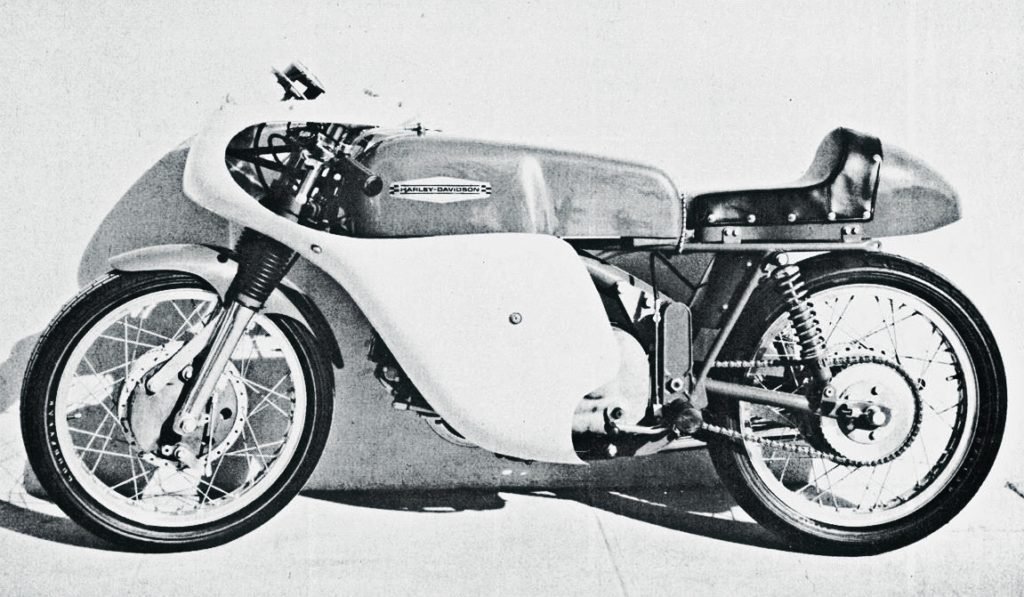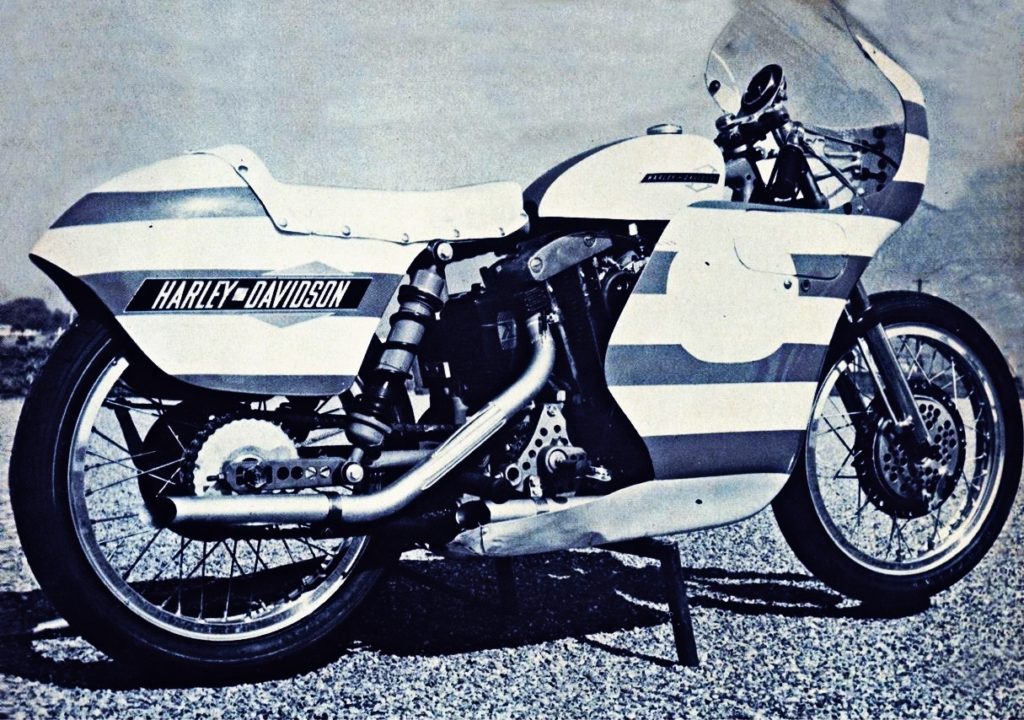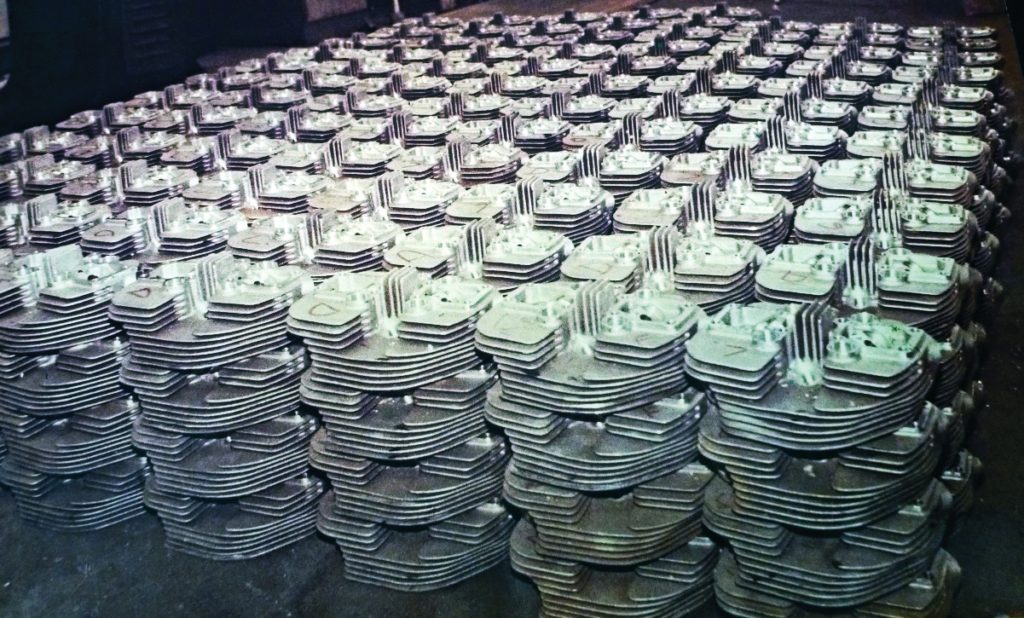
1954 – A young singer pushes his non-runner H-D 125 2-stroke into a local shop in Memphis. Hasn’t a clue. But he’s affable and down to earth. So is the mechanic. They get along immediately. One knows enough about his craft to become the “King.” The other knows enough about his to become a legend. The funny thing is, the singer knew how good the tuner was before the tuner knew how big the singer would get. Hall Of Fame futures for both! A few years later, Elvis Presley wouldn’t even think of taking his new Panhead to any other mechanic, because Jerry Branch wouldn’t even think of letting him ride it unless it ran as well as it could.
1963 – Jerry had moved to “Motorcycle Mecca” a few years earlier and was already known as “the man to see” for horsepower and performance through his work at Long Beach H-D. The factory had noticed too. Upcoming factory rider Dick Hammer was a left coaster and needed a mechanic for his race bikes. Branch was the natural choice. Testing the Sprint-based CR250 TT Hammer was to ride in the 250cc race that year, desperation was setting in. How could they find the power to keep up with the new Yamaha 2-strokes? Even the Honda Hawks were faster… by 5 mph or so on the bowl. Daytona is a horsepower track! The bike just didn’t want to run WFO, and no solution that had been thought of… had not been tried. The problem was carburetion… rather lack of consistent carburetion at full throttle. With a day to go it looked hopeless. Then it rained. The race was postponed. Jerry was at wit’s end. He thought and thought and thought some more. What if the fuel was frothing in the carb bowl? Couldn’t really… could it? He studied the carb bowl during the extra time and decided it was possible. The day of the race Hammer won going away! Beat all the metric bikes with a pushrod single fer krissake! It was the last time a 4-stroke won the 250 class at Daytona. The secret carb fix? Branch wrapped about a pound of solder around the carb float bowl and the high-speed vibes were kept under control so the engine could make full power.
That… folks… is a tuner!

1965 – A magazine does an article on the KR with Branch. Jerry had been building the fastest of ’em for a decade and it figured that he was the one who could explain what worked on the fastest “obsolete” racing motorcycle in history. Even today, vintage racers use the guidelines revealed in that story. That same year, there was another article in the same magazine… the one about the “Super Sportster.” In reality, an XLR engine stuffed into a KR racing chassis weighing less than 350 pounds ready to ride. The XLR was mostly a race engine, based on the OHV Iron 883… but making 82 hp! As the magazine put it, “Tell us if you can, who built the world’s most powerful road racing motorcycle? Should the names of famous Italian multis come to mind, then try again; you aren’t even warm. As a matter of fact (and this will make Count Agusta’s jaw muscles tighten) the bike in question is a Harley-Davidson, with elaborations by the firm’s racing department and that little old California speed-tuner Jerry Branch.” The story goes on to say that anyone could duplicate the bike… with the exception of the heads.
That… folks… is a clue!
1968 – Briggs & Stratton wins Daytona! Well, close! It was the flathead KR’s last hurrah on pavement, but it sure went out with a brilliant flash. Thanks to streamlining by Wixom, tuning by Branch and “porting and polishing” by… wait!.. C.R. Axtell? Yup, ironically, to get the last bit of power the side valve’er could offer, H-D went to see a man who tuned BSAs because he had one of the first flow benches. What came out of the experiment was domed pistons and matching heads… not to boost compression but to direct and manage airflow through an obsolete engine. It worked! (The KR was also to be the last Harley-Davidson to win the Daytona 200… a year later.) What did Branch do after he’d experienced all this? Build two flow benches, one for him and one for H-D. From then on, Branch became a specialist in a new science.
That.. .folks… is a game changer!


1970 – Drag racing Sportsters was the thing. Jerry Branch was the guy. His rapidly-acquired skills at going rapidly, through the science of head flow, were already renowned. He’d been building the quickest for years, and good heads made quick, quicker. It was also the first year of the KR’s replacement, the overhead valve iron XR. What had been known as “porting and polishing” and had been done mostly by gut and guesswork… was no longer. Tested flow, velocity taking precedence over volume, was what mattered. Nobody understood this better than Harley’s race boss Dick O’Brien… and Jerry Branch. (Pause—we are now talking about three distinct forms of iron X-heads… the XL, XLR and XR.) The reality is, no one did better or did more to improve the function of these heads than Branch. The porting part was (and is) about what you’d expect today, but new and cutting edge then. The polishing part… ah!… the debate still rages. Flowmetrics (and Branch-O’Keefe as it’s known today)… still polish. Here’s why. Branch commented on this obliquely as far back as October of 1970 in his interview with Jody Nicholas. Polishing did not improve or hurt flow much, he said. The big argument against polishing was that a smooth but not polished intake surface was better for fuel atomization. Maybe in cars… where intakes were a long ways from the valve… but Harley’s notoriously short intakes prevented much atomization in the port anyway. The real action was at the valve when it cracked open on compression. So now that you know what he knew, almost half a century ago, consider his polishing more a “signature” of quality than a feature and let it go.
That… folks… is knowledge!
1972 – It was the end of the “iron age” for Harley race bikes. For Branch it was a mandate. The new aluminum XR750 was the task at hand and H-D was knocking at his door… daily. The results speak for themselves… as in the record books. The XR750 was basically invincible from day one… every one with heads by Branch.
That… folks… is expertise!

1976 – Point proven (over and over by this time), Branch was proving it on a lot more than Harley-Davidsons. Fact is, he did Honda Fours, Kawasaki Z’s, Norton Twins, Triumph Twins and Triples, and more… even the occasional domestic V8. Business was booming. Or, should I say… “going—with the flow?” For instance, back in 1973 Norton had chosen to de-tune the 850 Commando in the name of reliability. Then, perversely issued a bulletin on hopping it up! There were velocity stacks involved, gutted mufflers, shorter pushrods, cams, milled heads, notched pistons and (believe it or not) DIY “porting” recommendations, complete with drawings. Once done, the E.T. at the drag strip improved by over a second! Then, wisely, the aforementioned magazine took the caboodle to Branch to see what he could do. The results @ .425 lift: stock flow 46.8 cubic feet per minute, factory mods (w/36mm Amals) 51.4 cfm… and Branch flowed heads (with 34mm Mikunis) 56.0 cfm. (XR heads from the same era rated at 56.8 cfm.)
Moreover, there were velocity measurements… Max for stock heads = 179 feet per second, factory mods = 173 fps (slower) and Branch… 215 fps! Meaning… Branch improved gross flow almost 10 cfm… and… velocity by a whopping 36 fps! At this stage an 850 Commando had other limitations… as did the XR750. Branch knew even then that his heads would often generate more power than the rest of the engine could tolerate. In the XR750 it was 140 hp heads on a 100 hp bottom end. A Norton would blow up at half that. Of course, there was also that day when a young, up-and-coming magazine editor that used to drag race Sportsters walked in the door to get Jerry’s help with their “underdog” road race bike… some little-known Italian thing called a Ducati Desmo SS. Look how that turned out!
That.. folks… is insight!
1982 – Branch ports stock heads for the limited production XR1000. He also “race” ports them for customers. Decides to publish what he finds. Wisdom greater than the data within the booklet is between the lines. Does the publishing thing four times eventually.
That… folks… is a learning experience.

1984 – Harley-Davidson introduced the engine that saved the company… the 1340cc Evolution Big Twin. Didn’t hurt Branch much either! Fact is, this was the heyday of Flowmetrics. Even during development, years earlier, Jerry had offered his notions of what the stock Evo heads should be. To deaf ears it turned out. So when the limitations of the standard “D-shaped” chamber (among other things) became known… he was ready. In the beginning, and for a while thereafter, modding the basic “D” was an avenue explored by many… not least Dick O’Brien himself. However, in the end, the clear superiority of so-called “Number 4”, bathtub-chambered heads by Branch won by a mile! H-D’s own Screamin’ Eagle heads for Evo Big Twins… although introduced almost 15 years later… strike many as a reluctant acknowledgment that the factory couldn’t do any better. Only more “affordable.”
That… folks… is a testament!

1990 – It has been said that Branch “retired”… but he never really did. Instead, he was helping the likes of New Zealander John Britten develop heads for his visionary V1000 racer. He advised on the Harley VR1000. Towards the end of the decade, he sold the business to Mikuni, who sort of ran it into the ground until long-term cohort and disciple John O’Keefe saved it and continues today in the same vein as Jerry. Along the way plenty of other head flow practitioners burst on the scene… in the “sincerest form of flattery” sense. All… owe a debt to the pathfinder, the man who showed the way to go… was flow.
This… folks… is to his memory.
Jerry Branch: 1924-2018…
his influence continues.




















Absolutely, Jerry Branch did research work for all 3 of the American car companies, all 4 of the Japanese motorcycle companies, Indy racing teams, NASCAR teams, NASA, and just too many more to list.
Sears and Roebuck even contracted him to improve the ductwork in a vacuum cleaner of their’s, when they assembled it with the ductwork of his design and turned it on it pulled down to the carpet so hard it couldn’t be moved and had to be built with a lower powered motor which turned out to be a selling feature.
And while he never offered his services to the public for anything but Harley Davidson heads that meant he was always our ace in the hole, having the best head flower in the world willing to do heads for us.
Legend has it that it was Jerry’s shop that Max Balchowsky used to hang around in to learn about flowing and it was from Jerry that Max learned about the importance of velocity over volume.
For those of you who don’t know who Max Balchowsky is he’s the man that hand built a race car called Old Yeller II, it beat every Ferrari, Jaguar, Aston Martin and all the other high end European sports car thrown at it including the Maserati Birdcage which was supposed to be the most advanced race car in the world at the time, Max is also the man who prepped the 2 Mustang’s and 3 Charger’s for the movie Bullitt and too many other movie cars to list.